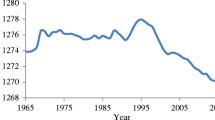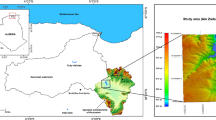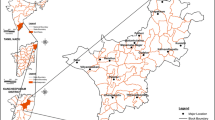Abstract
Monitoring and determining the amount of water in reservoirs is of great importance in terms of water planning and management. This study proposes a geographic information system (GIS)-based methodology to estimate the water volume changes in water reservoirs. Two specific methods are proposed using Australian National University’s Digital Elevation Model (ANUDEM) raster surface and Triangulated Irregular Network (TIN) surface models, both utilizing normalized difference water index (NDWI) of Sentinel 2A satellite images for water-covered area and coastline and digital elevation model (DEM) for 3D modelling of the reservoir. The most crucial part of this study is the comprehensive evaluation of the model findings considering hydrological, meteorological and anthropogenic factors, simultaneously. Application of the proposed methods is provided for the analysis of the multi-temporal water volume changes of Bayramiç Dam Lake (Çanakkale, Turkey) in two hydrological periods covering the 2015–2016 and 2016–2017 water years. The results indicate that the TINS model produced water volume values much closer to the in situ Turkish General Directorate of State Hydraulic Works (DSI) values than the ANUDEM model. The performance of these methods was also assessed by the temporal dynamics of surface hydrological processes. Regarding the water storage dynamics, hydro-meteorological factors influence the water input, while anthropogenic factors strongly influence the water output. Water consumption for irrigation and electricity generation was found to be the most important water budget components of the total water consumption.














Similar content being viewed by others
Data availability
The hydrological, meteorological and topographic data that support the findings of this study are available from the General Directorate of State Hydraulic Works, the Turkish State Meteorological Service and the General Directorate of National Mapping, respectively, but restrictions apply to the availability of these data, which were used under license for the current study, and so are not publicly available. Data are however available from the authors upon reasonable request and with permission of the listed institutions above. The sattellite data, Sentinel, used during this research is openly available from the European Space Agency at https://scihub.copernicus.eu/dhus/#/home.
References
Akbulak, C. (2010a). The population characteristics of the Kara Menderes Basin, Çanakkale. Journal of Human Sciences, 7(2), 577–610. https://www.j-humansciences.com/ojs/index.php/IJHS/article/view/1340. Accessed 1 Nov 2020.
Akbulak, C. (2010b). Land use suitability analysis of the Upper Basin of the Kara Menderes River using analytical hierarchy process and geographical information systems. Journal of Human Sciences, 7(2), 557–576. https://www.j-humansciences.com/ojs/index.php/IJHS/article/view/1305. Accessed 1 Nov. 2020.
Akbulut, M., Odabaşı, S, Odabaşı, D., & Çelik, E. (2006). Çanakkale i̇li’nin önemli i̇çsuları ve kirletici kaynakları. E.U. Journal of Fisheries & Aquatic Sciences, 23. http://jfas.ege.edu.tr/. Accessed 1 Nov 2020.
Alsdorf, D. E., Rodríguez, E., & Lettenmaier, D. P. (2007). Measuring surface water from space. Reviews of Geophysics. https://doi.org/10.1029/2006RG000197
Altan, G., & Türkeş, M. (2011). Çanakkale yöresinde oluşan orman yanginlarinin hidroklimatolojik karakteristikleri ve iklim değişimleriyle ilişkisi. Ege Coğrafya Dergisi. Ege Üniversitesi.
Asbury, Z., & Aly, M. H. (2019). A geospatial study of the drought impact on surface water reservoirs: Study cases from Texas. GIScience and Remote Sensing. https://doi.org/10.1080/15481603.2019.1582154
Avisse, N., Tilmant, A., Müller, M. F., & Zhang, H. (2017a). Monitoring small reservoirs’ storage with satellite remote sensing in inaccessible areas. Hydrology and Earth System Sciences, 21(12), 6445–6459. https://doi.org/10.5194/hess-21-6445-2017
Avisse, N., Tilmant, A., Müller, M. F., & Zhang, H. (2017b). Monitoring small reservoirs storage from satellite remote sensing in inaccessible areas. Hydrology and Earth System Sciences Discussions, 1–23. https://doi.org/10.5194/hess-2017-373
Bonnema, M., Sikder, S., Miao, Y., Chen, X., Hossain, F., Ara Pervin, I., et al. (2016). Understanding satellite-based monthly-to-seasonal reservoir outflow estimation as a function of hydrologic controls. Water Resources Research. https://doi.org/10.1002/2015WR017830
Çetinkaya, O., & Sümer, A. (2013). Karamenderes havzası topraklarının yarayışlı mikro besin elementlerinin (Fe, Cu, Zn ve Mn) Durumu. COMU Journal of Agriculture Faculty.
Ceylan, A., & Ekizoglu, I. (2014). Assesment of bathymetric maps via GIS for water in reservoir. Boletim De Ciências Geodésicas. https://doi.org/10.1590/s1982-21702014000100010
ÇGPDEUM (Çanakkale Governorship Provincial Directorate of Environment and Urban Management). (2017). Çanakkale Province 2016 Environmental Status Report [Çanakkale İli 2016 Yılı İl Çevre Durum Raporu]. 134p. Çanakkale. https://webdosya.csb.gov.tr/db/ced/editordosya/Canakkale_icdr2016.pdf. Accessed 14 December 2021
Cohen, S., Brakenridge, G. R., Kettner, A., Bates, B., Nelson, J., McDonald, R., et al. (2018). Estimating floodwater depths from flood inundation maps and topography. Journal of the American Water Resources Association. https://doi.org/10.1111/1752-1688.12609
Delaunay, B. (1934). Sur la sphère vide. A la mémoire de Georges Voronoï. l’Académie des sciences de l’URSS.
Eslamian, S., Gohari, A. R., Ostad-Ali-Askari, K., & Sadeghi, N. (2018). Reservoirs. In P. T. Bobrowsky & M. Brian (Eds.), Encyclopedia of Engineering Geology (pp. 746–750). Springer.
Feyisa, G. L., Meilby, H., Fensholt, R., & Proud, S. R. (2014). Automated water extraction index: A new technique for surface water mapping using Landsat imagery. Remote Sensing of Environment, 140, 23–35. https://doi.org/10.1016/j.rse.2013.08.029
Fisher, A., Flood, N., & Danaher, T. (2016). Comparing Landsat water index methods for automated water classification in eastern Australia. Remote Sensing of Environment, 175, 167–182. https://doi.org/10.1016/j.rse.2015.12.055
Fuentes, I., Padarian, J., van Ogtrop, F., & Vervoort, R. W. (2019). Comparison of surface water volume estimation methodologies that couple surface reflectance data and digital terrain models. Water (Switzerland), 11(4). https://doi.org/10.3390/w11040780
Godwin, W. H., & Cole, W. F. (2018). Dams. In P. T. Bobrowsky & B. Marker (Eds.), Encyclopedia of Engineering Geology (pp. 193–205). Springer.
Güre, M., Özel, M. E., & Özcan, H. (2009). Corine arazi kullanımı sınıflandırma sistemine göre Çanakkale İli. Harran Üniversitesi Ziraat Fakültesi Dergisi, 13(3). https://app.trdizin.gov.tr//makale/T1RJd09EQXc
Gürsoy, Ö., & Atun, R. (2019). Investigating surface water pollution by integrated remotely sensed and field spectral measurement data: a case study. Polish Journal of Environmental Studies. https://doi.org/10.15244/pjoes/90598
Hollister, J., & Milstead, W. B. (2010). Using GIS to estimate lake volume from limited data. Lake and Reservoir Management, 26(3), 194–199. https://doi.org/10.1080/07438141.2010.504321
Huang, L. K., & Wang, M. J. J. (1995). Image thresholding by minimizing the measures of fuzziness. Pattern Recognition, 28(1), 41–51. https://doi.org/10.1016/0031-3203(94)E0043-K
Hutchinson, M. F. (1988). Calculation of hydrologically sound digital elevation models. In Proceedings of the Third International Symposium on data handling.
Hutchinson, M. F. (1989). A new procedure for gridding elevation and stream line data with automatic removal of spurious pits. Journal of Hydrology. https://doi.org/10.1016/0022-1694(89)90073-5
Hutchinson, M. F. (1996). A locally adaptive approach to the interpolation of digital elevation models. In Proceedings, Third International Conference/Workshop on Integrating GIS and Environmental Modeling (pp. 21–26). Santa Barbara, CA: National Center for Geographic Information and Analysis.
Hutchinson, M. F. (2000). Optimising the degree of data smoothing for locally adaptive finite element bivariate smoothing splines. ANZIAM Journal. https://doi.org/10.21914/anziamj.v42i0.621
Hutchinson, M. F., Xu, T., & Stein, J. A. (2011). Recent Progress in the ANUDEM Elevation Gridding Procedure. Geomorphometry, 19–22.
Ji, L., Geng, X., Sun, K., Zhao, Y., & Gong, P. (2015). Target detection method for water mapping using landsat 8 OLI/TIRS Imagery. Water (switzerland). https://doi.org/10.3390/w7020794
Jiang, F., Qi, S., Liao, F., Ding, M., & Wang, Y. (2014). Vulnerability of Siberian crane habitat to water level in Poyang Lake wetland, China. Giscience & Remote Sensing, 51(6), 662–676. https://doi.org/10.1080/15481603.2014.978126
Karaman, M. (2021). Comparison of thresholding methods for shoreline extraction from Sentinel-2 and Landsat-8 imagery: Extreme Lake Salda, track of Mars on Earth. Journal of Environmental Management, 298, 113481. https://doi.org/10.1016/J.JENVMAN.2021.113481
Karaman, M., Budakoglu, M., Avci, Z. D. U., Ozelkan, E., Bulbul, A., Civas, M., & Tasdelen, S. (2015). Determination of seasonal changes in wetlands using CHRIS / Probahyperspectral satellite images : A case study fromAcıgöl. Journal of Environmental Biology, 36(1), 73–83.
Karaman, M., Özelkan, E., & Taşdelen, S. (2018). Dar Nehirlerin Sentinel2-A Uydu Görüntüleri ile Belirlenebilirliğinde Havza Hidrojeolojisinin Etkisi: Karamenderes (Çanakkale) Örneği. Doğal Afetler ve Çevre Dergisi, 4(2), 140–155. https://doi.org/10.21324/dacd.416514
Khattab, O., & M. F., Abo, R. K., Al-Muqdadi, S. W., & Merkel, B. J. (2017). Generate reservoir depths mapping by using digital elevation model: A case study of Mosul Dam Lake, Nothern Iraq. Advances in Remote Sensing, 06(03), 161–174. https://doi.org/10.4236/ars.2017.63012
Kim, Y. S., Park, D. G., Jung, H. Y., Cho, H. G., Dong, J. J., & Ku, K. J. (1999). An improved TIN compression using Delaunay triangulation. In Proceedings - 7th Pacific Conference on Computer Graphics and Applications, Pacific Graphics 1999 (pp. 128–137). Institute of Electrical and Electronics Engineers Inc. https://doi.org/10.1109/PCCGA.1999.803355
Ko, B. C., Kim, H. H., & Nam, J. Y. (2015). Classification of potential water bodies using landsat 8 OLI and a combination of two boosted random forest classifiers. Sensors (switzerland). https://doi.org/10.3390/s150613763
Lu, S., Ouyang, N., Wu, B., Wei, Y., & Tesemma, Z. (2013). Lake water volume calculation with time series remote-sensing images. International Journal of Remote Sensing, 34(22), 7962–7973. https://doi.org/10.1080/01431161.2013.827814
Ma, S., Zhou, Y., Gowda, P. H., Dong, J., Zhang, G., Kakani, V. G., et al. (2019). Application of the water-related spectral reflectance indices: a review. Ecological Indicators, 98, 68–79. https://doi.org/10.1016/j.ecolind.2018.10.049
Main-Knorn, M., Pflug, B., Louis, J., Debaecker, V., Müller-Wilm, U., & Gascon, F. (2017). Sen2Cor for sentinel-2. https://doi.org/10.1117/12.2278218, 10427, 37–48. https://doi.org/10.1117/12.2278218
Maltese, A., Pipitone, C., Dardanelli, G., Capodici, F., Muller, J.-P., Armenteros, M. R., et al. (2021). Toward a comprehensive dam monitoring: on-site and remote-retrieved forcing factors and resulting displacements (GNSS and PS–InSAR). Remote Sensing, 13(8), 1543. https://doi.org/10.3390/RS13081543
Mandanici, E., & Bitelli, G. (2016). Preliminary comparison of sentinel-2 and landsat 8 imagery for a combined use. Remote Sensing. https://doi.org/10.3390/rs8121014
McFeeters, S. K. (1996). The use of the Normalized Difference Water Index (NDWI) in the delineation of open water features. International Journal of Remote Sensing. https://doi.org/10.1080/01431169608948714
MuellerWilm, U. (2019). Sen2Cor Configuration and User Manual.
Özelkan, E. (2019). Comparison of remote sensing classification techniques for water body detection: a case studY in Atikhisar Dam Lake (Çanakkale). Cumhuriyet Science Journal, 40(3), 650–661. https://doi.org/10.17776/csj.556440
Özelkan, E. (2020). Water body detection analysis using NDWI indices derived from landsat-8 OLI. Polish Journal of Environmental Studies. https://doi.org/10.15244/pjoes/110447
Pipitone, C., Maltese, A., Dardanelli, G., Brutto, M. L., & Loggia, G. L. (2018). Monitoring water surface and level of a reservoir using different remote sensing approaches and comparison with dam displacements evaluated via GNSS. Remote Sensing, 10(1), 1–24. https://doi.org/10.3390/rs10010071
Policelli, F., Hubbard, A., Jung, H. C., Zaitchik, B., & Ichoku, C. (2019). A predictive model for Lake Chad total surface water area using remotely sensed and modeled hydrological and meteorological parameters and multivariate regression analysis. Journal of Hydrology, 568, 1071–1080. https://doi.org/10.1016/j.jhydrol.2018.11.037
Popielarczyk, D., & Templin, T. (2009). Inventory taking of the upper water reservoir in pumped-storage power station in Zydowo using classical land survey methods and integrated hydroacoustic and global navigation satellite systems. Reports on Geodesy, (Vol. z. 2/87).
Prewitt, J. M. S., & Mendelsohn, M. L. (1966). The analysis of cell images*. Annals of the New York Academy of Sciences, 128(3), 1035–1053.
Schindelin, J., Arganda-Carreras, I., Frise, E., Kaynig, V., Longair, M., Pietzsch, T., et al. (2012). Fiji: an open-source platform for biological-image analysis. Nature Methods. Nature Publishing Group. https://doi.org/10.1038/nmeth.2019
Sekertekin, A. (2020). A survey on global thresholding methods for mapping open water body using Sentinel-2 satellite imagery and normalized difference water index. Archives of Computational Methods in Engineering, 1, 3. https://doi.org/10.1007/s11831-020-09416-2
Sensoy, S., Demircan, M., Ulupinar, Y., & Balta, İ. (2008). Turkish State Meteorological Services Report: Türkiye İklimi [Climate of Turkey]. Ankara. https://www.mgm.gov.tr/FILES/genel/makale/13_turkiye_iklimi.pdf. Accessed 1 Nov 2020.
Shi, W., Wang, B., & Tian, Y. (2014). Accuracy analysis of digital elevation model relating to spatial resolution and terrain slope by bilinear interpolation. Mathematical Geosciences, 46(4), 445–481. https://doi.org/10.1007/S11004-013-9508-8
Šiljeg, A., Lozić, S., & Radoš, D. (2015). The effect of interpolation methods on the quality of a digital terrain model for geomorphometric analyses. Tehnički Vjesnik, 22, 1149–1156. https://doi.org/10.17559/TV-20131010223216
Tsihrintzis, V. A., Hamid, R., & Fuentes, H. R. (1996). Use of Geographic Information Systems (GIS) in water resources: a review. Water Resources Management, 10(4), 251–277. https://doi.org/10.1007/BF00508896
Xu, H. (2006). Modification of normalised difference water index (NDWI) to enhance open water features in remotely sensed imagery. International Journal of Remote Sensing, 27(14), 3025–3033. https://doi.org/10.1080/01431160600589179
Xue, Y., Sun, M., & Ma, A. (2004). On the reconstruction of three-dimensional complex geological objects using Delaunay triangulation. Future Generation Computer Systems, 20(7), 1227–1234. https://doi.org/10.1016/j.future.2003.11.012
Yang, Y., Liu, Y., Zhou, M., Zhang, S., Zhan, W., Sun, C., & Duan, Y. (2015). Landsat 8 OLI image based terrestrial water extraction from heterogeneous backgrounds using a reflectance homogenization approach. Remote Sensing of Environment. https://doi.org/10.1016/j.rse.2015.10.005
Yue, H., & Liu, Y. (2019). Variations in the lake area, water level, and water volume of Hongjiannao Lake during 1986–2018 based on Landsat and ASTER GDEM data. Environmental Monitoring and Assessment, 191(10), 1–25. https://doi.org/10.1007/s10661-019-7715-6
Zheng, X., Xiong, H., Yue, L., & Gong, J. (2016). An improved ANUDEM method combining topographic correction and DEM interpolation. Geocarto International, 31(5), 492–505. https://doi.org/10.1080/10106049.2015.1059899
Zhu, Q., Zhang, Y., & Li, F. (2008). Three-dimensional TIN algorithm for digital terrain modeling. Geo-Spatial Information Science. https://doi.org/10.1007/s11806-008-0043-6
Acknowledgements
The authors would like to thank the Turkish State Meteorological Service for the meteorological data, the General Directorate of State Hydraulic Works for dam management data, the European Space Agency for Sentinel satellite images and the General Directorate of National Mapping for the topographic map.
Funding
The Scientific Research Project Coordination Unit of Çanakkale Onsekiz Mart University provided funding support.
Author information
Authors and Affiliations
Contributions
MK: conceptualization; methodology; software; validation; formal analysis; investigation; data curation; visualization; writing — original draft, review and editing, supervision. EÖ: conceptualization; validation; formal analysis; investigation; data curation; visualization; writing – original draft, review and editing, supervision; funding acquisition.
Corresponding author
Ethics declarations
Competing interests
The authors declare no competing interests.
Additional information
Publisher's note
Springer Nature remains neutral with regard to jurisdictional claims in published maps and institutional affiliations.
Highlights
• The consistency of the dam volume with the measured in situ volume shows that the Sentinel-2A images provide appropriate data for determining the temporal changes in the dam volume.
• It is easier to calculate the water volume using the proposed methodology which comprise continuous monitoring of the dam with satellite images and the underwater topography data before dam construction.
• Regarding the dam volume dynamics, hydro-meteorological factors influence the input parameters, while anthropogenic factors strongly influence the output parameters.
Rights and permissions
About this article
Cite this article
Karaman, M., Özelkan, E. Comparative assessment of remote sensing–based water dynamic in a dam lake using a combination of Sentinel-2 data and digital elevation model. Environ Monit Assess 194, 92 (2022). https://doi.org/10.1007/s10661-021-09703-w
Received:
Accepted:
Published:
DOI: https://doi.org/10.1007/s10661-021-09703-w




